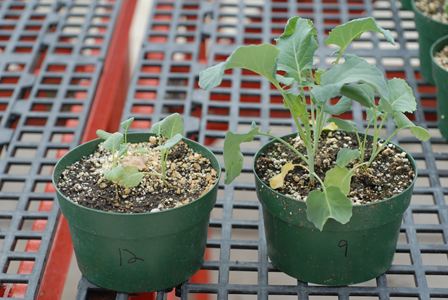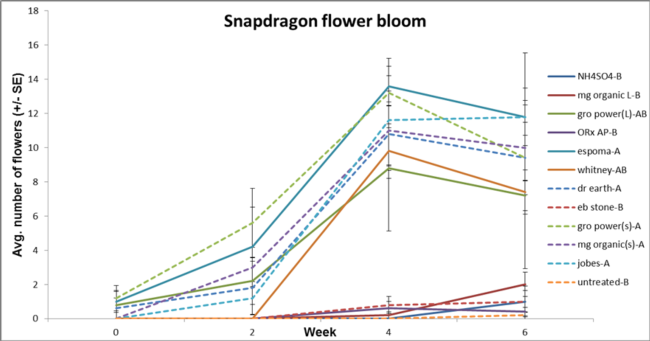Fall 2013: A comparison of organic fertilizers
Regional Report Ventura County by Jim Downer
The “organic” movement in the United States has gained considerable momentum over the last ten years. Greenhouse and nursery growers are showing increasing interest in “organic” and “sustainable” growing practices, including the use of organic fertilizers. Although the number of commercial certified organic fertilizer products is limited, there are a plethora of products for sale in retail nurseries for gardeners; yet, efficacy testing of these products is largely missing. While organic fertilizers are generally believed to be “slow release,” there is potential for nutrient loss from containers because organic fertilizers tend to be applied at higher rates or more frequently than soluble fertilizers.
Staff Research Associate Anna Howell and I evaluated several retail organic fertilizer products and two experimental products on the quality, growth and chlorophyll content of vegetables, flowers and an herb. We also examined nitrate leaching.
Methods
Greenhouse container studies were set up using basil, petunia, broccoli (fig. 1) and snapdragons. The container media was a peatmoss: perlite mix (50:50 vol/vol), without added fertilizer. Fertilizers were suspended or dissolved in 100 ml of water and applied every two weeks at rates calibrated to supply 300 ppm of actual nitrogen to each container. Fertilizer treatments we evaluated and the specific rates for each treatment are shown in table 1.
The following were recorded every two weeks:
- Quality, rated as a visual index from 1 = dead to 10 = perfect florist quality.
- Number of flowers (petunia and snapdragon).
- Chlorophyll content measured in petunia and broccoli using the SPAD meter (Minolta Inc.).
- Nitrate content of leachate caught from each container and measured using a nitrate meter (Horiba Ltd.).

Fig. 1. Greenhouse container setup using broccoli transplants, control (left) vs. Gro Power Solid (right). Photo by Jim Downer.
Table 1. Organic fertilizer products and application rates.
| Product | Manufacturer |
NPK analysis |
Rate (g/L or ml/l) |
|
Ammonium sulfate |
Various |
21-0-0 |
1.6 g |
|
Miracle-Gro All Purpose Plant Food |
Scotts Miracle-Gro Inc. | 24-8-16 | 1.2 g |
| Espoma Garden Tone | Espoma Co. | 3-3-4 | 13.3 g |
| Whitney Farms Organic and Natural All Purpose | Rod McLellan Co | 4-2-3 | 10.0 g |
| Dr. Earth All Purpose | Dr. Earth Co. | 4-4-4 | 10.0 g |
| Miracle-Gro Organic Blood Meal | Scotts Miracle-Gro Inc. | 12-0-0 | 3.3 g |
| E.B. Stone All Purpose | EB Stone and Sons Inc. | 5-5-5 | 8.0 g |
| Jobes Organic All Purpose | Easy Gardener Products Inc. | 4-4-4 | 10.0 g |
| Miracle-Gro Organic Choice All Purpose | Scotts Miracle-Gro Inc. | 7-1-2 | 5.7 |
| Organic Rx Vegetable | Organics Rx | 5-1-3 | 8.0 g |
| Organic Rx Plant Food | Organics Rx | 5-1.3-3 | 8.0 g |
| Scotts AP | Experimental | 11.0 ml | |
| Scotts PC | Experimental | 12.0 ml | |
| Organic Rx Plant Food +Sea Kelp 100 | Organics Rx | 5-1.3-3 0.2-0-0.2 |
8.0 g 7.8 ml |
| Organic Rx Vegetable + Sea Kelp 100 | Organics Rx | 5-1-3 0.2-0-0.2 |
8.0 g 7.8 ml |
| Miracle-Gro Organic Choice (Liquid) | Scotts Miracle-Gro | 8-0-0 | 6.7 ml |
| Gro-Power All Purpose (Liquid) | Gro Power, Inc. | 4-8-2 | 13.4 ml |
| Gro-Power All Purpose (Solid) | Gro Power, Inc. | 4-8-2 | 8.0 g |
| Untreated | -- | -- | -- |
Flowering and Plant Quality Responses
Several products for snapdragon, including Espoma and Gro-Power solid, promoted flower bloom (fig. 2). While all products stimulated some response, the Scott’s experimental “AP” and “PC” products appeared to evoke the greatest number of flowers and higher quality levels in the petunia; basil quality was largely unaffected by treatment (data not shown).
The organic fertilizers supplied N, P and K as well as other minerals but at very low concentration requiring frequent applications. While all the fertilizer treatments performed well, the Scotts and Gro-Power products were most effective in our trials (data not shown).
Chlorophyll Content and Nitrate Losses
A brief summary of other findings are reported here (data not shown). Petunias fertilized with soluble sources gave significantly higher SPAD readings than other treatments; SPAD readings on plants with organic treatments were not different than untreated plants. However, chlorophyll content was not associated with plant quality as several treatments in petunia with high SPAD readings did not have high quality ratings for the same date.
Nitrate losses from plants fertilized with the soluble fertilizers were high initially but dropped rapidly. As organic treatments mineralized, nitrate readings increased, especially in Scott’s experimental product “PC” and the retail Miracle-Gro Organic Choice. Most other materials had similar nitrate loss rates, which were not significantly different than unfertilized containers.

Fig 2. Snapdragon flower production over time.
James Downer
Environmental Horticulture Advisor
UC Cooperative Extension Ventura County
669 County Square Drive, #100
Ventura, CA 93003-5401
(805) 645-1458 phone
(805) 645-1474 fax












